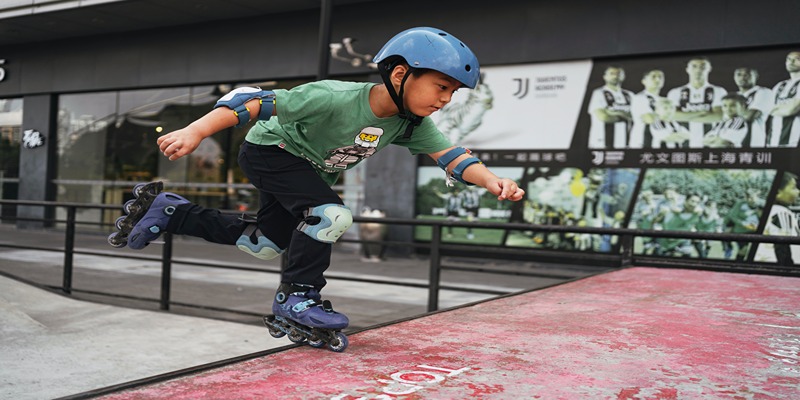The popularity of both indoor and outdoor roller skating has increased as individuals seek enjoyment and engage in physical activity. Nevertheless, it is crucial to bear in mind that roller skating is not devoid of risks, especially for those who are new to the activity or those who are returning to the sport after a prolonged hiatus. This article will provide comprehensive insights into the primary precautions that have to be observed while engaging in roller skating activities.

Fundamentals of Skating Gear
Appropriate Footwear Choices
The first measure in ensuring safety when roller skating is the selection of suitable footwear. Skaters want footwear that offers enough support, optimal comfort, and a snug fit that does not compromise their comfort. It is advisable to choose a pair of shoes that have a thick and very adhesive sole. Wearing footwear that is too loose or fails to adequately enclose the toes heightens the likelihood of sustaining injuries. To ensure stability and mastery throughout the act of skating, a majority of skaters choose for well fitted sneakers or athletic footwear.
Necessity of Protective Gear
The use of protective gear is of utmost importance while engaging in the activity of roller skating. The use of appropriate safety equipment significantly reduces the probability of sustaining injuries. The use of essential protective gear, including a suitable helmet, wrist guards, elbow pads, and knee pads, is compulsory. These items have the potential to mitigate the impact of a fall, hence decreasing the probability of sustaining severe injuries such as abrasions and fractures. Skaters, regardless of their level of experience, should consistently prioritize the importance of using safety gear. Regular use of this item instills a sense of confidence in skaters, enabling them to disregard the potential hazards associated with injury and focus their attention on the enjoyment of the activity.
New Skater Tips: Pre-Skating Preparations
Picking a Suitable Terrain
Selecting an appropriate skating location is of utmost importance for those who are new to the activity. Select locations that are flat and free from debris and obstacles. Skate parks that have designated skate zones, rinks, and well maintained pavements provide excellent prospects. It is advisable to avoid locations characterized by excessive congestion or uneven terrain. To acquire skating skills and enhance self-assurance, it is advisable to practice on a surface that has qualities of sturdiness and leniency.

Preliminary Exercises for Balance
The incorporation of balance training is crucial for those who are new to the sport of skating. It is advisable to focus on improving one's balance on stable surfaces prior to trying to walk on uneven terrain such as pavement. One may develop familiarity with skating by engaging in basic exercises like maintaining balance on a single foot, stabilizing oneself while stationary, or executing gentle back-and-forth movements on a level skating area. Engaging in these routines might potentially enhance the core strength and balance of skaters. The activity of skating may be an enjoyable and straightforward endeavor if one dedicates sufficient time to acquiring the skill of balance prior to engaging with the wheels.
Skate Precautions While in Motion
Maintaining Appropriate Speed
Learning to effectively control one's speed is a crucial element in ensuring safety when engaging in roller skating activities. Maintain a consistent speed that is suitable for your individual skating proficiency, taking into consideration the prevailing weather conditions and the state of the ice surface. It is advisable to first approach tasks with a deliberate and gradual pace, then increasing momentum as one acquires expertise and familiarity. It is advisable for skaters to show more care while descending slopes and acquire proficiency in effectively managing and reducing their velocity using techniques like as the "pizza" and "T-stop." Maintaining a controlled and safe skating experience necessitates the consistent adherence to permissible speed restrictions. In the context of acquiring new skills, prioritizing safety above speed is crucial.
Proper Stance and Body Alignment
Achieving and maintaining balance and control while roller skating requires the adoption of an ideal stance and body alignment. To enhance balance and response speed, it is advisable to maintain a lower center of gravity via the flexion of the knees. Maintain a balanced center of gravity inside the skate to minimize any inclination towards either the front or back. Maintain a relaxed posture by keeping your arms in a loose position, and using them as a means of stabilizing oneself if necessary. Maintaining a linear body alignment might potentially reduce the risk of stumbling and enhance one's ability to adapt to variations in the landscape or obstacles encountered along the way.
Techniques for Safe Turning and Stopping
Acquiring the necessary skills to execute controlled and secure pivots and stops on roller skates is an essential need for all skaters. The execution of controlled turns may be achieved by using a modest inclination towards the intended direction and utilizing the arms to aid in the preservation of equilibrium. Acquiring proficiency in deceleration and cessation procedures is of paramount significance. Consequently, it is advisable to enhance one's knowledge and skills pertaining to stopping maneuvers such as the T-stop and the plow stop. By acquiring proficiency in these abilities, individuals will enhance their ability to effectively control their speed and maintain stability when maneuvering around turns, navigating obstacles, and adapting to dynamic changes in the skating environment.
Situational Awareness and External Variables
Weather Conditions
The conditions for skating are highly influenced by meteorological factors. Engaging in skating activities in inclement weather conditions, such as rain, snow, or on wet surfaces, might pose potential risks and hazards. It is essential for skaters to consistently consult the weather forecast before venturing onto the ice, and under no circumstances should they expose themselves to hazardous weather conditions. It is advisable to use more care, reduce speed, and employ appropriate strategies to maintain control while skating on slippery surfaces under unfavorable weather conditions. To safeguard oneself against the natural forces, it is advisable to equip oneself with appropriate attire such as rain boots, a raincoat, and waterproof gloves.
Navigating through Crowded Spaces
Greater care should be used while engaging in skating activities in densely populated areas. It is advisable to exercise vigilance towards other road users who use the same transportation infrastructure, such as pedestrians, cyclists, and skateboarders. When engaging in the act of passing or navigating in the vicinity of other individuals, it is advisable to use hand gestures or vocalize one's intentions in order to effectively communicate one's actions to others present. Maintain an appropriate distance and be prepared to decelerate promptly if circumstances require. In order to mitigate the risk of possible accidents and ensure the safety of oneself and others, it is advisable to adjust one's speed and actions in accordance with the density of individuals present in the vicinity.
Common Pitfalls and How to Evade Them
Usually, those who engage in skating activities tend to commit the error of overestimating their abilities. Accidents are more prone to transpire when inexperienced skaters attempt intricate maneuvers or engage in excessive speed. Having a clear understanding of one's current position and diligently progressing towards higher levels of achievement is of utmost importance. It is advisable to acquire proficiency in fundamental skills such as halting and maneuvering before engaging in more intricate actions.
Neglecting minor discomforts such as stiffness or blisters may potentially lead to the development of more severe complications in the future. In the event that any sensations of pain or discomfort arise during the act of skating, it is imperative to promptly cease the activity.
Conclusion
The cultivation of skills such as practice, concentration, and patience will prove to be advantageous in one's pursuit of attaining proficiency and confidence when it comes to roller skating. The experience of skating is enhanced when individuals have achieved proficiency in fundamental skills, maintain constant vigilance of their surroundings, and demonstrate awareness of prevailing environmental factors. It is advisable to refrain from progressing to more intricate techniques until one has attained proficiency in the fundamental concepts. It is essential to consistently prioritize one's well-being and enjoyment. By diligently applying effort and prioritizing safety measures, individuals may participate in the exhilarating activity of roller skating while minimizing potential risks and maximizing their overall pleasure. The experience of joy is evoked by the presence of ice.




